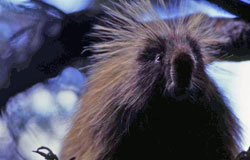Land Mammal Viewing
To learn about some of Alaska’s most popular land mammals and where you might see them, click on the links below. Be sure to check back again as we continue to build the website and add more animals to the list.
Porcupine
Description
 The North American porcupine is one of the largest rodents in Alaska, second only to the beaver. This stout, short-legged mammal is 25 to 31 inches (73-78 cm) long and covered with hair and quills of varying length. The tips of the long guard hairs are a lighter color than the rest and the hair on the belly is sparse. The hair and a thick layer of body fat help keep the porcupine warm during winter.
The North American porcupine is one of the largest rodents in Alaska, second only to the beaver. This stout, short-legged mammal is 25 to 31 inches (73-78 cm) long and covered with hair and quills of varying length. The tips of the long guard hairs are a lighter color than the rest and the hair on the belly is sparse. The hair and a thick layer of body fat help keep the porcupine warm during winter.
The porcupine has an extremely muscular tail that it uses for climbing and defense. The upper surface of the tail is thickly covered with quills while the underside is covered in bristle-like hairs, which aid in climbing. Quills are modified hairs that have microscopic barbs on the tips and are filled with a spongy matrix. Quills from different parts of the body vary in length, flexibility, color, shaft diameter, and barb length. When it is alarmed and its quills are bristled, the porcupine also emits a pungent odor as a warning. Once an animal has tangled with a porcupine, the smell may serve as a deterrent the next time.
Male porcupines often fight each other—using their incisor teeth and quills as weapons— for the opportunity to mate with a receptive female. The winner, usually the largest porcupine, then splashes the female with urine. If she is not ready to mate, she shakes off the urine and leaves. If she is ready, she stays and the male mounts in the traditional posture with the female in front and the male in the rear. She will curl her tail over her back, covering most of the quills.
The average weight of an adult male porcupine ranges from 15 to 18 lbs (7-8.5 kg), but some individuals can weigh up to 30 lbs (13.6 kg). Adult females weigh about two to four lbs (0.9-1.8kg) less than the males. The porcupine has an excellent sense of smell, hearing, and taste, but its eyesight is relatively poor. Porcupines make a wide variety of sounds ranging from whimpers to screams, depending upon the circumstance.
The inner bark of spruce, birch and hemlock and spruce needles are the major winter foods for porcupines in Alaska. In spring and summer, they eat buds and young green leaves of birch, aspen, cottonwood, and willow until the tannin levels build too high to tolerate. Because their foods are very low in sodium, porcupines seek out salt sources such as natural licks, glue which bonds plywood together, human perspiration on tools, road salt, and some paints. Porcupines also feed on shed antlers and the bones of dead animals to obtain sodium and calcium.
Habitat
The common porcupine lives in coniferous, deciduous and mixed forests. It also thrives in scrubby tundra areas and rocky slopes.
Viewing
The porcupine is found throughout all of Alaska except the Alaska Peninsula and Kodiak, Nunivak, and St. Lawrence islands. In wooded areas, porcupines are easy to spot in trees chewing on leaves or waddling across the trail. In northern areas like Nome, willow bark is their primary food, but they can be encountered almost anywhere, from high rocky slopes to tundra meadows.
